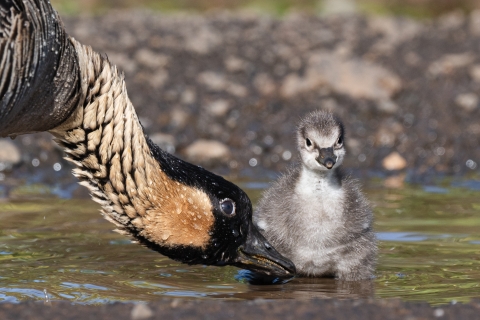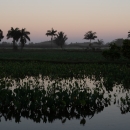About Us
Kīlauea Point National Wildlife Refuge was established in 1985 to protect and enhance migratory seabirds and threatened and endangered species and their habitats. It was expanded in 1988 to include Mōkōlea Point and Nihokū, a portion of the Kīlauea volcanic vent and spectacular 568-foot ocean bluff. The focus of Refuge management is to expand and enhance existing habitat for those species the Refuge protects, while combating the primary threats of invasive species invasive species
An invasive species is any plant or animal that has spread or been introduced into a new area where they are, or could, cause harm to the environment, economy, or human, animal, or plant health. Their unwelcome presence can destroy ecosystems and cost millions of dollars.
Learn more about invasive species and allowing for public uses that are compatible with Refuge purposes and the National Wildlife Refuge System mission.
The Refuge is home to thousands of migratory and resident seabirds including:
- mōlī (Laysan albatross),
- ‘ā (red-footed boobies),
- koa‘e ‘ula (red-tailed tropicbird)
- koa‘e kea (white-tailed tropicbird)
- ‘iwa (great frigatebirds)
- ‘ua‘u kani (wedge-tailed shearwaters)
- kōlea (Pacific golden plover)
- nēnē (Hawaiian goose, threatened)
- ‘a‘o (Newell's shearwater, threatened)
- pueo (Hawaiian short-eared owl)
Humpback whales (Megaptera novaeangliae), threatened green sea turtles (Chelonia mydas), and endangered Hawaiian monk seals (Neomonachus schauinslandi) can be spotted in the Hawaiian Islands Humpback Whale National Marine Sanctuary just offshore.
The Refuge is also home to the historic Daniel K. Inouye Kīlauea Point Lighthouse and Light Station, listed on the National Register of Historic Places in 1979. The Lighthouse and Light Station sit on the northernmost point of Kaua‘i and the high Hawaiian Islands. The Lighthouse was built in 1913 as a navigational aid for commercial shipping between Asia and Hawai‘i. For 62 years, the light guided ships safely along Kaua‘i's rugged north shore.
Native plants are grown in an on-site nursery in an ongoing effort to restore native coastal communities.
Cultural and natural resources are interpreted at the Visitor Center, by staff and volunteers, and signs located along the pathway to Kīlauea Point.
Visitors can also browse through the Visitor Center Nature Store, which is run by the Friends of Kaua‘i Wildlife Refuges (FKWR), a non-profit organization that supports the environmental and wildlife conservation, historic preservation and community education programs of the Kauaʻi National Wildlife Refuge (NWR) Complex.
Wildlife viewing, the lighthouse, and dramatic views makes this refuge a top attraction on Kaua‘i.





